A Research Proposal on Biometric Technology in the Workplace
VerifiedAdded on 2023/01/23
|32
|6641
|83
Report
AI Summary
This research proposal investigates the implementation of biometric technology in the workplace, addressing its benefits, ethical considerations, and potential drawbacks. The proposal begins with a background on the increasing popularity of biometric systems, such as fingerprint scanners and facial recognition, highlighting their advantages over traditional authentication methods like passwords. The research questions focus on the helpfulness of biometric techniques, employee awareness of their benefits, and employee support for their use. The literature review covers an overview of biometric technology, its advantages (enhanced security, time-saving), and disadvantages (potential for misuse, privacy concerns). The methodology section explores various research approaches, including questionnaires, interviews, surveys, focus groups, and case studies, ultimately selecting interviews and surveys as the primary methods for data collection. The proposal also examines the use of biometric technology in the UK, including its application in schools and various sectors. The abstract provides a concise overview of the study's focus on the impact of biometric technology on workplace practices. Keywords include: the workplace, monitoring, workplace punctuality, and biometric technology.

Running Head: RESEARCH PROPOSAL
Research Proposal
Name of the Student
Name of the University
Author Note
Research Proposal
Name of the Student
Name of the University
Author Note
Paraphrase This Document
Need a fresh take? Get an instant paraphrase of this document with our AI Paraphraser
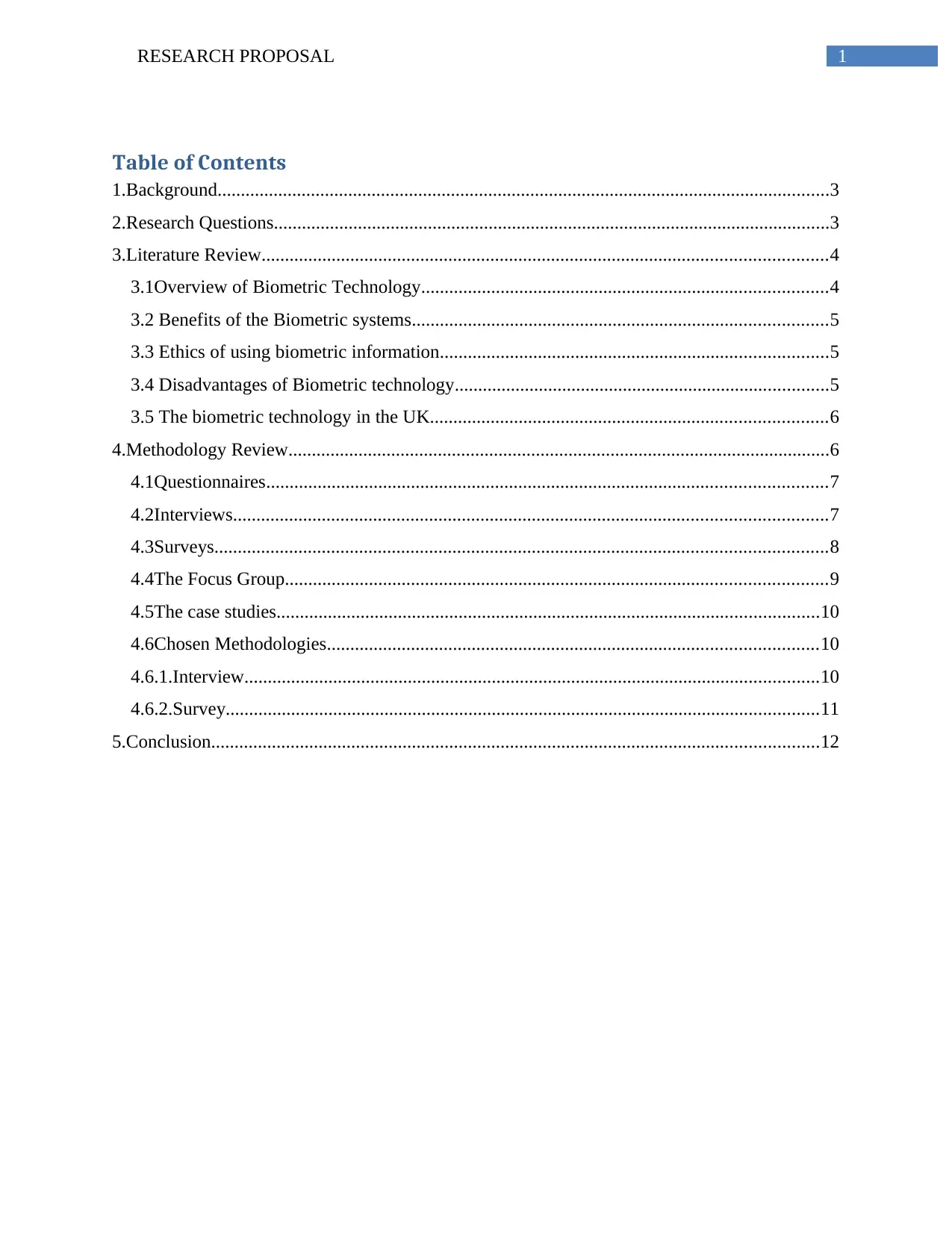
1RESEARCH PROPOSAL
Table of Contents
1.Background...................................................................................................................................3
2.Research Questions.......................................................................................................................3
3.Literature Review.........................................................................................................................4
3.1Overview of Biometric Technology.......................................................................................4
3.2 Benefits of the Biometric systems.........................................................................................5
3.3 Ethics of using biometric information...................................................................................5
3.4 Disadvantages of Biometric technology................................................................................5
3.5 The biometric technology in the UK.....................................................................................6
4.Methodology Review....................................................................................................................6
4.1Questionnaires........................................................................................................................7
4.2Interviews...............................................................................................................................7
4.3Surveys...................................................................................................................................8
4.4The Focus Group....................................................................................................................9
4.5The case studies....................................................................................................................10
4.6Chosen Methodologies.........................................................................................................10
4.6.1.Interview...........................................................................................................................10
4.6.2.Survey...............................................................................................................................11
5.Conclusion..................................................................................................................................12
Table of Contents
1.Background...................................................................................................................................3
2.Research Questions.......................................................................................................................3
3.Literature Review.........................................................................................................................4
3.1Overview of Biometric Technology.......................................................................................4
3.2 Benefits of the Biometric systems.........................................................................................5
3.3 Ethics of using biometric information...................................................................................5
3.4 Disadvantages of Biometric technology................................................................................5
3.5 The biometric technology in the UK.....................................................................................6
4.Methodology Review....................................................................................................................6
4.1Questionnaires........................................................................................................................7
4.2Interviews...............................................................................................................................7
4.3Surveys...................................................................................................................................8
4.4The Focus Group....................................................................................................................9
4.5The case studies....................................................................................................................10
4.6Chosen Methodologies.........................................................................................................10
4.6.1.Interview...........................................................................................................................10
4.6.2.Survey...............................................................................................................................11
5.Conclusion..................................................................................................................................12
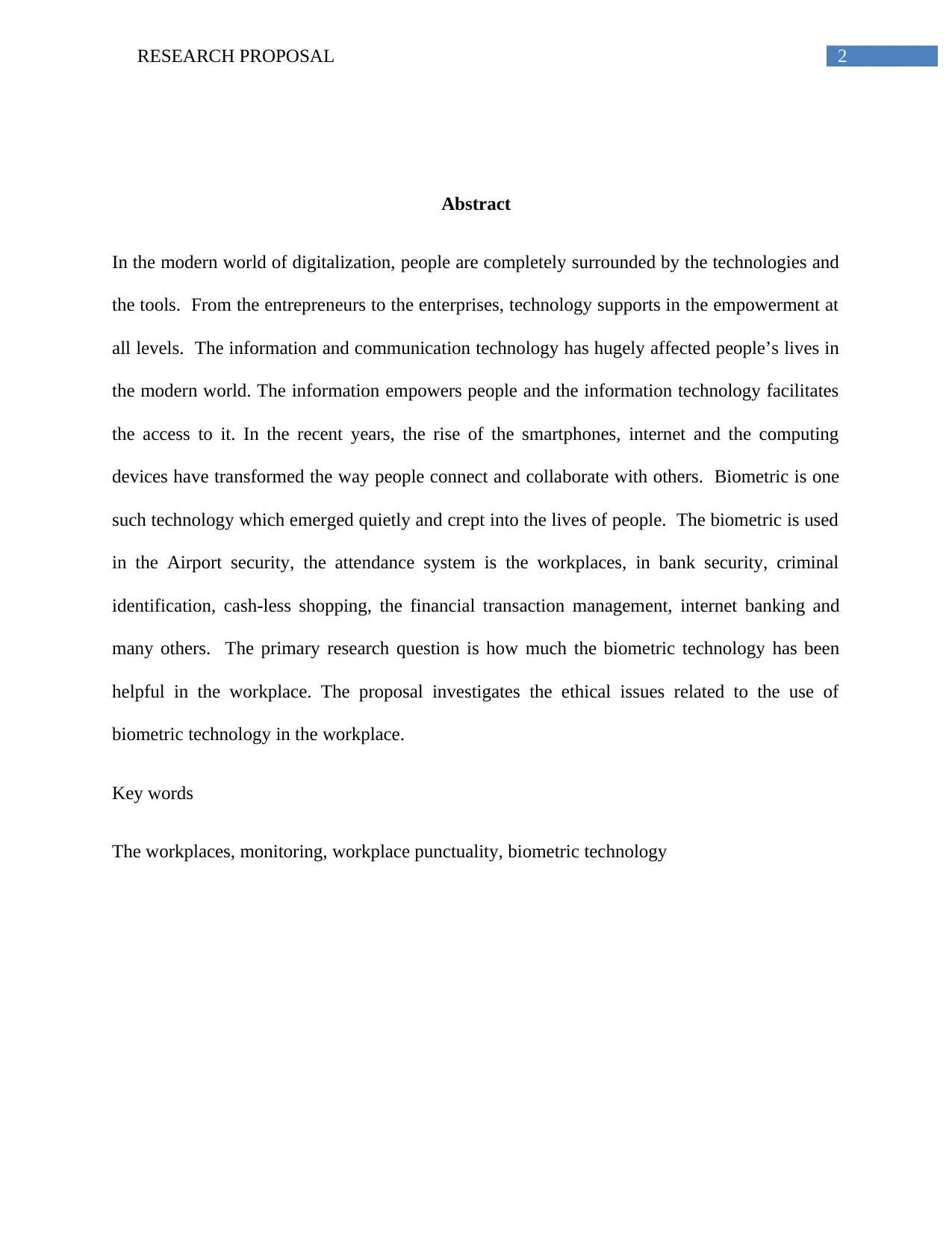
2RESEARCH PROPOSAL
Abstract
In the modern world of digitalization, people are completely surrounded by the technologies and
the tools. From the entrepreneurs to the enterprises, technology supports in the empowerment at
all levels. The information and communication technology has hugely affected people’s lives in
the modern world. The information empowers people and the information technology facilitates
the access to it. In the recent years, the rise of the smartphones, internet and the computing
devices have transformed the way people connect and collaborate with others. Biometric is one
such technology which emerged quietly and crept into the lives of people. The biometric is used
in the Airport security, the attendance system is the workplaces, in bank security, criminal
identification, cash-less shopping, the financial transaction management, internet banking and
many others. The primary research question is how much the biometric technology has been
helpful in the workplace. The proposal investigates the ethical issues related to the use of
biometric technology in the workplace.
Key words
The workplaces, monitoring, workplace punctuality, biometric technology
Abstract
In the modern world of digitalization, people are completely surrounded by the technologies and
the tools. From the entrepreneurs to the enterprises, technology supports in the empowerment at
all levels. The information and communication technology has hugely affected people’s lives in
the modern world. The information empowers people and the information technology facilitates
the access to it. In the recent years, the rise of the smartphones, internet and the computing
devices have transformed the way people connect and collaborate with others. Biometric is one
such technology which emerged quietly and crept into the lives of people. The biometric is used
in the Airport security, the attendance system is the workplaces, in bank security, criminal
identification, cash-less shopping, the financial transaction management, internet banking and
many others. The primary research question is how much the biometric technology has been
helpful in the workplace. The proposal investigates the ethical issues related to the use of
biometric technology in the workplace.
Key words
The workplaces, monitoring, workplace punctuality, biometric technology
⊘ This is a preview!⊘
Do you want full access?
Subscribe today to unlock all pages.

Trusted by 1+ million students worldwide
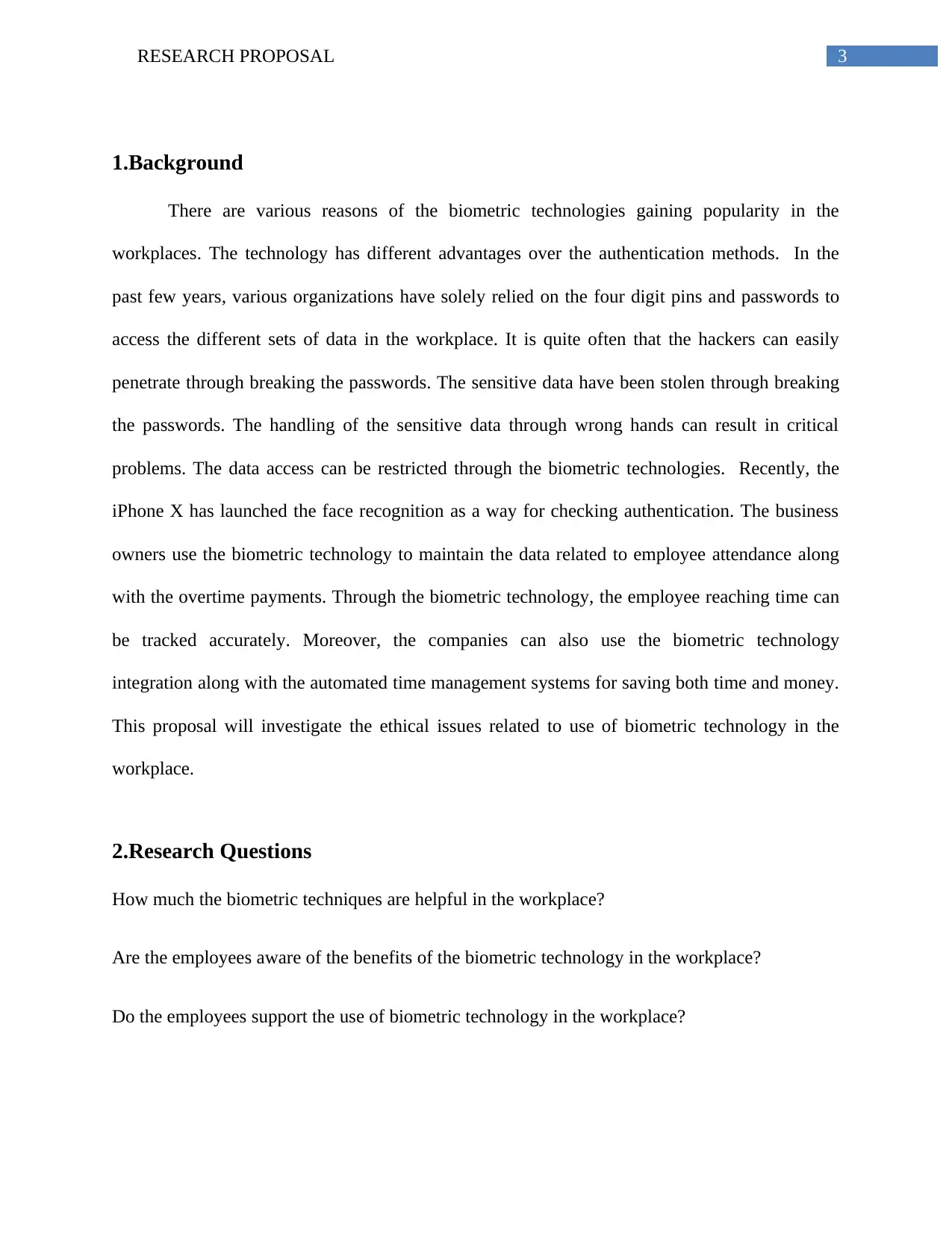
3RESEARCH PROPOSAL
1.Background
There are various reasons of the biometric technologies gaining popularity in the
workplaces. The technology has different advantages over the authentication methods. In the
past few years, various organizations have solely relied on the four digit pins and passwords to
access the different sets of data in the workplace. It is quite often that the hackers can easily
penetrate through breaking the passwords. The sensitive data have been stolen through breaking
the passwords. The handling of the sensitive data through wrong hands can result in critical
problems. The data access can be restricted through the biometric technologies. Recently, the
iPhone X has launched the face recognition as a way for checking authentication. The business
owners use the biometric technology to maintain the data related to employee attendance along
with the overtime payments. Through the biometric technology, the employee reaching time can
be tracked accurately. Moreover, the companies can also use the biometric technology
integration along with the automated time management systems for saving both time and money.
This proposal will investigate the ethical issues related to use of biometric technology in the
workplace.
2.Research Questions
How much the biometric techniques are helpful in the workplace?
Are the employees aware of the benefits of the biometric technology in the workplace?
Do the employees support the use of biometric technology in the workplace?
1.Background
There are various reasons of the biometric technologies gaining popularity in the
workplaces. The technology has different advantages over the authentication methods. In the
past few years, various organizations have solely relied on the four digit pins and passwords to
access the different sets of data in the workplace. It is quite often that the hackers can easily
penetrate through breaking the passwords. The sensitive data have been stolen through breaking
the passwords. The handling of the sensitive data through wrong hands can result in critical
problems. The data access can be restricted through the biometric technologies. Recently, the
iPhone X has launched the face recognition as a way for checking authentication. The business
owners use the biometric technology to maintain the data related to employee attendance along
with the overtime payments. Through the biometric technology, the employee reaching time can
be tracked accurately. Moreover, the companies can also use the biometric technology
integration along with the automated time management systems for saving both time and money.
This proposal will investigate the ethical issues related to use of biometric technology in the
workplace.
2.Research Questions
How much the biometric techniques are helpful in the workplace?
Are the employees aware of the benefits of the biometric technology in the workplace?
Do the employees support the use of biometric technology in the workplace?
Paraphrase This Document
Need a fresh take? Get an instant paraphrase of this document with our AI Paraphraser
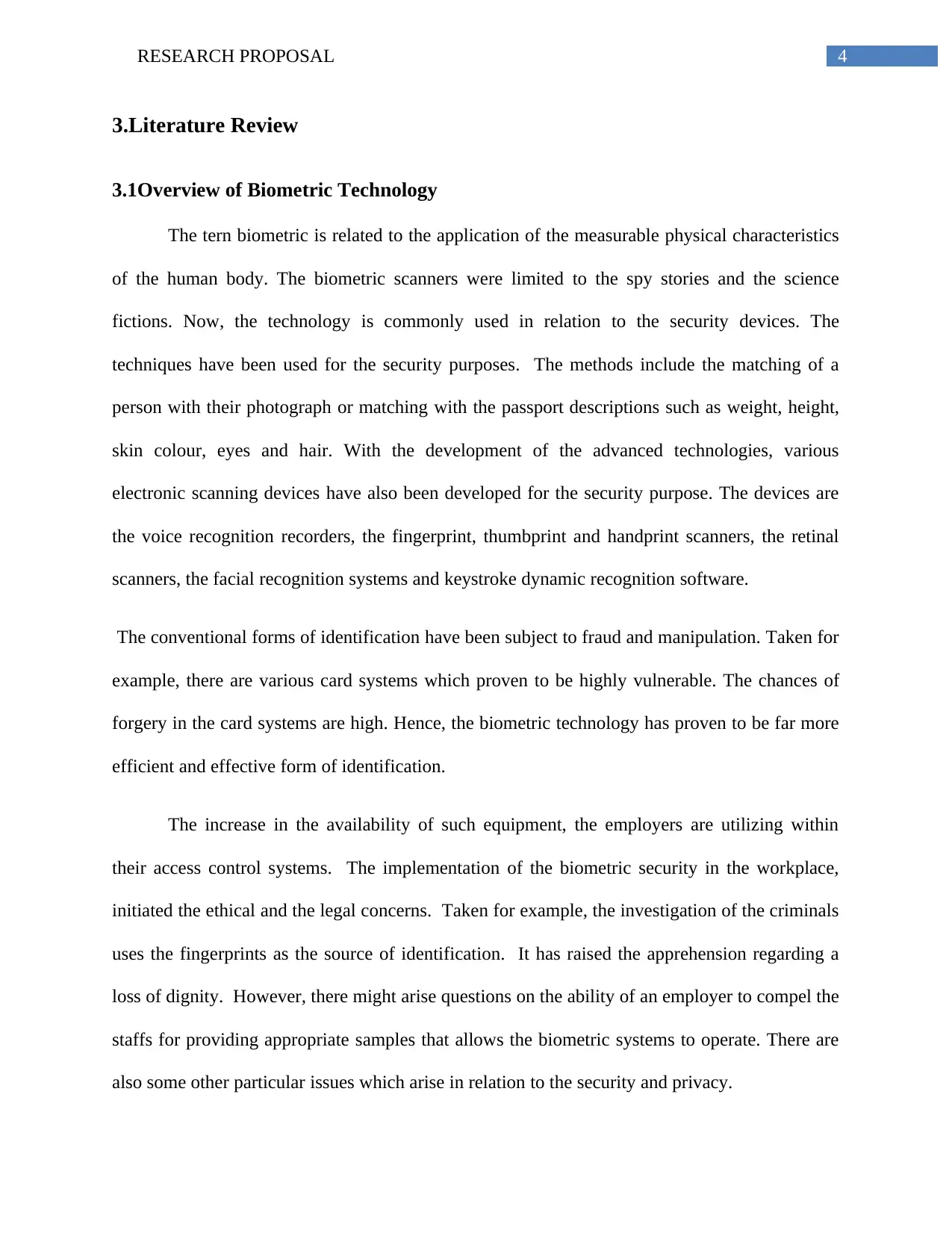
4RESEARCH PROPOSAL
3.Literature Review
3.1Overview of Biometric Technology
The tern biometric is related to the application of the measurable physical characteristics
of the human body. The biometric scanners were limited to the spy stories and the science
fictions. Now, the technology is commonly used in relation to the security devices. The
techniques have been used for the security purposes. The methods include the matching of a
person with their photograph or matching with the passport descriptions such as weight, height,
skin colour, eyes and hair. With the development of the advanced technologies, various
electronic scanning devices have also been developed for the security purpose. The devices are
the voice recognition recorders, the fingerprint, thumbprint and handprint scanners, the retinal
scanners, the facial recognition systems and keystroke dynamic recognition software.
The conventional forms of identification have been subject to fraud and manipulation. Taken for
example, there are various card systems which proven to be highly vulnerable. The chances of
forgery in the card systems are high. Hence, the biometric technology has proven to be far more
efficient and effective form of identification.
The increase in the availability of such equipment, the employers are utilizing within
their access control systems. The implementation of the biometric security in the workplace,
initiated the ethical and the legal concerns. Taken for example, the investigation of the criminals
uses the fingerprints as the source of identification. It has raised the apprehension regarding a
loss of dignity. However, there might arise questions on the ability of an employer to compel the
staffs for providing appropriate samples that allows the biometric systems to operate. There are
also some other particular issues which arise in relation to the security and privacy.
3.Literature Review
3.1Overview of Biometric Technology
The tern biometric is related to the application of the measurable physical characteristics
of the human body. The biometric scanners were limited to the spy stories and the science
fictions. Now, the technology is commonly used in relation to the security devices. The
techniques have been used for the security purposes. The methods include the matching of a
person with their photograph or matching with the passport descriptions such as weight, height,
skin colour, eyes and hair. With the development of the advanced technologies, various
electronic scanning devices have also been developed for the security purpose. The devices are
the voice recognition recorders, the fingerprint, thumbprint and handprint scanners, the retinal
scanners, the facial recognition systems and keystroke dynamic recognition software.
The conventional forms of identification have been subject to fraud and manipulation. Taken for
example, there are various card systems which proven to be highly vulnerable. The chances of
forgery in the card systems are high. Hence, the biometric technology has proven to be far more
efficient and effective form of identification.
The increase in the availability of such equipment, the employers are utilizing within
their access control systems. The implementation of the biometric security in the workplace,
initiated the ethical and the legal concerns. Taken for example, the investigation of the criminals
uses the fingerprints as the source of identification. It has raised the apprehension regarding a
loss of dignity. However, there might arise questions on the ability of an employer to compel the
staffs for providing appropriate samples that allows the biometric systems to operate. There are
also some other particular issues which arise in relation to the security and privacy.
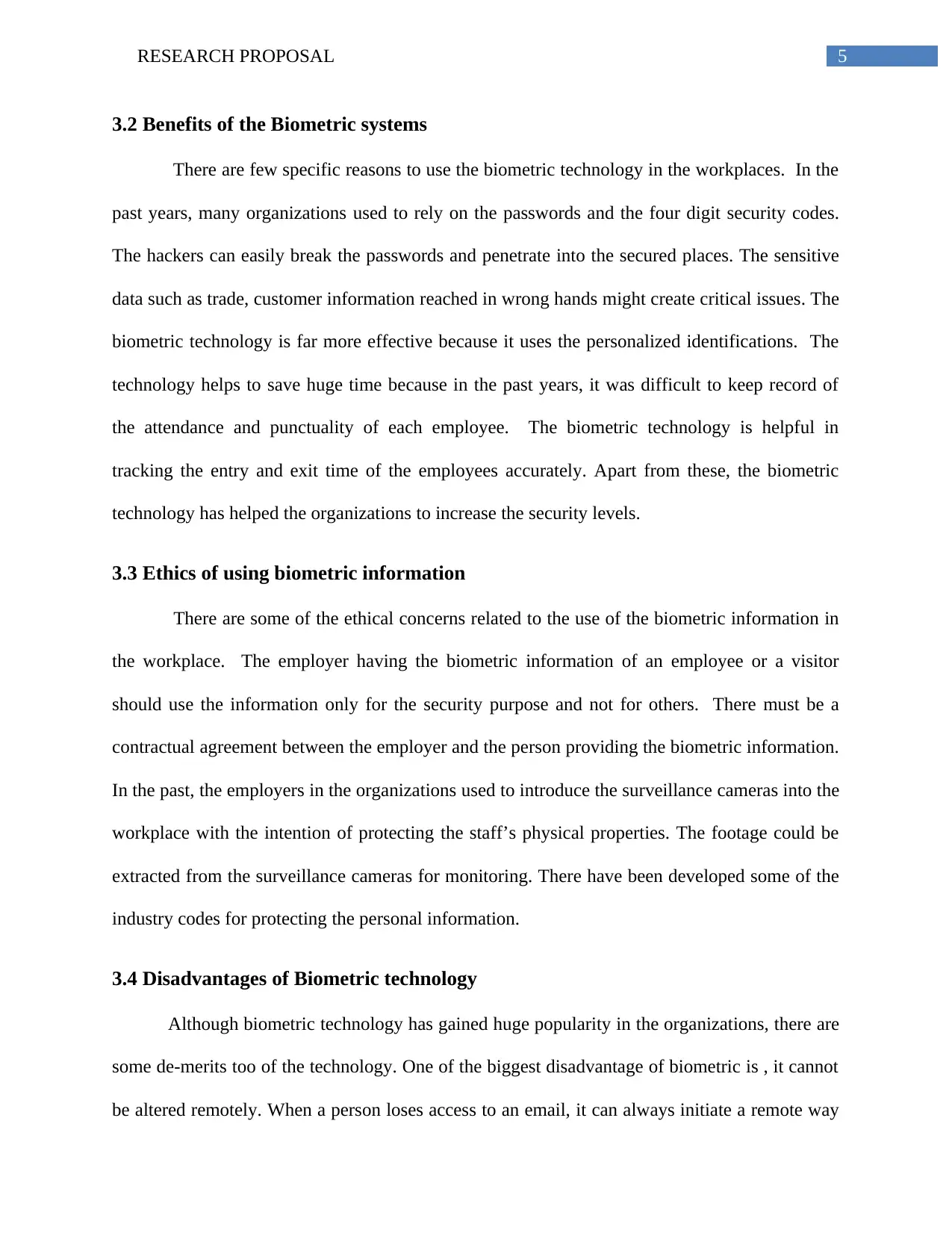
5RESEARCH PROPOSAL
3.2 Benefits of the Biometric systems
There are few specific reasons to use the biometric technology in the workplaces. In the
past years, many organizations used to rely on the passwords and the four digit security codes.
The hackers can easily break the passwords and penetrate into the secured places. The sensitive
data such as trade, customer information reached in wrong hands might create critical issues. The
biometric technology is far more effective because it uses the personalized identifications. The
technology helps to save huge time because in the past years, it was difficult to keep record of
the attendance and punctuality of each employee. The biometric technology is helpful in
tracking the entry and exit time of the employees accurately. Apart from these, the biometric
technology has helped the organizations to increase the security levels.
3.3 Ethics of using biometric information
There are some of the ethical concerns related to the use of the biometric information in
the workplace. The employer having the biometric information of an employee or a visitor
should use the information only for the security purpose and not for others. There must be a
contractual agreement between the employer and the person providing the biometric information.
In the past, the employers in the organizations used to introduce the surveillance cameras into the
workplace with the intention of protecting the staff’s physical properties. The footage could be
extracted from the surveillance cameras for monitoring. There have been developed some of the
industry codes for protecting the personal information.
3.4 Disadvantages of Biometric technology
Although biometric technology has gained huge popularity in the organizations, there are
some de-merits too of the technology. One of the biggest disadvantage of biometric is , it cannot
be altered remotely. When a person loses access to an email, it can always initiate a remote way
3.2 Benefits of the Biometric systems
There are few specific reasons to use the biometric technology in the workplaces. In the
past years, many organizations used to rely on the passwords and the four digit security codes.
The hackers can easily break the passwords and penetrate into the secured places. The sensitive
data such as trade, customer information reached in wrong hands might create critical issues. The
biometric technology is far more effective because it uses the personalized identifications. The
technology helps to save huge time because in the past years, it was difficult to keep record of
the attendance and punctuality of each employee. The biometric technology is helpful in
tracking the entry and exit time of the employees accurately. Apart from these, the biometric
technology has helped the organizations to increase the security levels.
3.3 Ethics of using biometric information
There are some of the ethical concerns related to the use of the biometric information in
the workplace. The employer having the biometric information of an employee or a visitor
should use the information only for the security purpose and not for others. There must be a
contractual agreement between the employer and the person providing the biometric information.
In the past, the employers in the organizations used to introduce the surveillance cameras into the
workplace with the intention of protecting the staff’s physical properties. The footage could be
extracted from the surveillance cameras for monitoring. There have been developed some of the
industry codes for protecting the personal information.
3.4 Disadvantages of Biometric technology
Although biometric technology has gained huge popularity in the organizations, there are
some de-merits too of the technology. One of the biggest disadvantage of biometric is , it cannot
be altered remotely. When a person loses access to an email, it can always initiate a remote way
⊘ This is a preview!⊘
Do you want full access?
Subscribe today to unlock all pages.

Trusted by 1+ million students worldwide
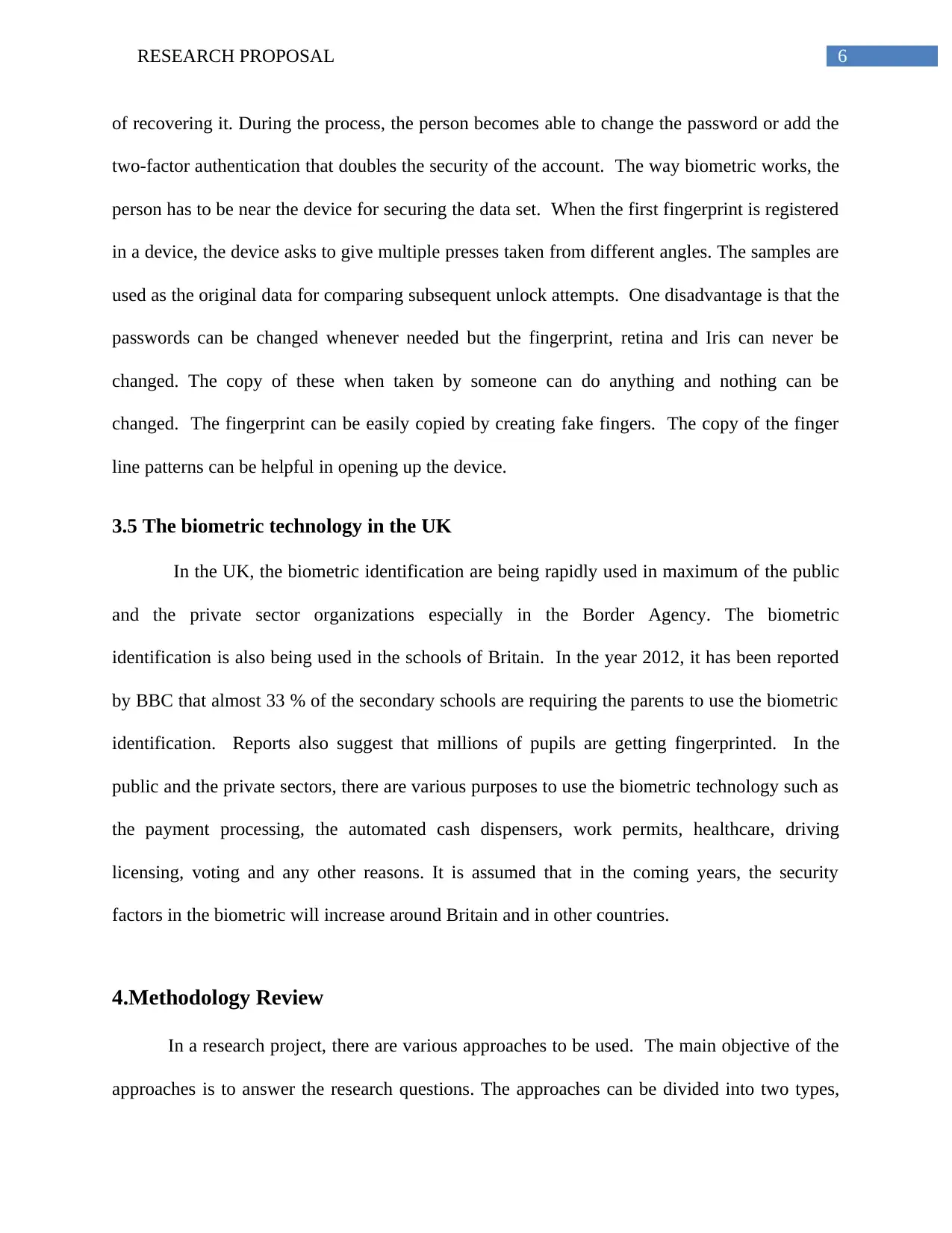
6RESEARCH PROPOSAL
of recovering it. During the process, the person becomes able to change the password or add the
two-factor authentication that doubles the security of the account. The way biometric works, the
person has to be near the device for securing the data set. When the first fingerprint is registered
in a device, the device asks to give multiple presses taken from different angles. The samples are
used as the original data for comparing subsequent unlock attempts. One disadvantage is that the
passwords can be changed whenever needed but the fingerprint, retina and Iris can never be
changed. The copy of these when taken by someone can do anything and nothing can be
changed. The fingerprint can be easily copied by creating fake fingers. The copy of the finger
line patterns can be helpful in opening up the device.
3.5 The biometric technology in the UK
In the UK, the biometric identification are being rapidly used in maximum of the public
and the private sector organizations especially in the Border Agency. The biometric
identification is also being used in the schools of Britain. In the year 2012, it has been reported
by BBC that almost 33 % of the secondary schools are requiring the parents to use the biometric
identification. Reports also suggest that millions of pupils are getting fingerprinted. In the
public and the private sectors, there are various purposes to use the biometric technology such as
the payment processing, the automated cash dispensers, work permits, healthcare, driving
licensing, voting and any other reasons. It is assumed that in the coming years, the security
factors in the biometric will increase around Britain and in other countries.
4.Methodology Review
In a research project, there are various approaches to be used. The main objective of the
approaches is to answer the research questions. The approaches can be divided into two types,
of recovering it. During the process, the person becomes able to change the password or add the
two-factor authentication that doubles the security of the account. The way biometric works, the
person has to be near the device for securing the data set. When the first fingerprint is registered
in a device, the device asks to give multiple presses taken from different angles. The samples are
used as the original data for comparing subsequent unlock attempts. One disadvantage is that the
passwords can be changed whenever needed but the fingerprint, retina and Iris can never be
changed. The copy of these when taken by someone can do anything and nothing can be
changed. The fingerprint can be easily copied by creating fake fingers. The copy of the finger
line patterns can be helpful in opening up the device.
3.5 The biometric technology in the UK
In the UK, the biometric identification are being rapidly used in maximum of the public
and the private sector organizations especially in the Border Agency. The biometric
identification is also being used in the schools of Britain. In the year 2012, it has been reported
by BBC that almost 33 % of the secondary schools are requiring the parents to use the biometric
identification. Reports also suggest that millions of pupils are getting fingerprinted. In the
public and the private sectors, there are various purposes to use the biometric technology such as
the payment processing, the automated cash dispensers, work permits, healthcare, driving
licensing, voting and any other reasons. It is assumed that in the coming years, the security
factors in the biometric will increase around Britain and in other countries.
4.Methodology Review
In a research project, there are various approaches to be used. The main objective of the
approaches is to answer the research questions. The approaches can be divided into two types,
Paraphrase This Document
Need a fresh take? Get an instant paraphrase of this document with our AI Paraphraser
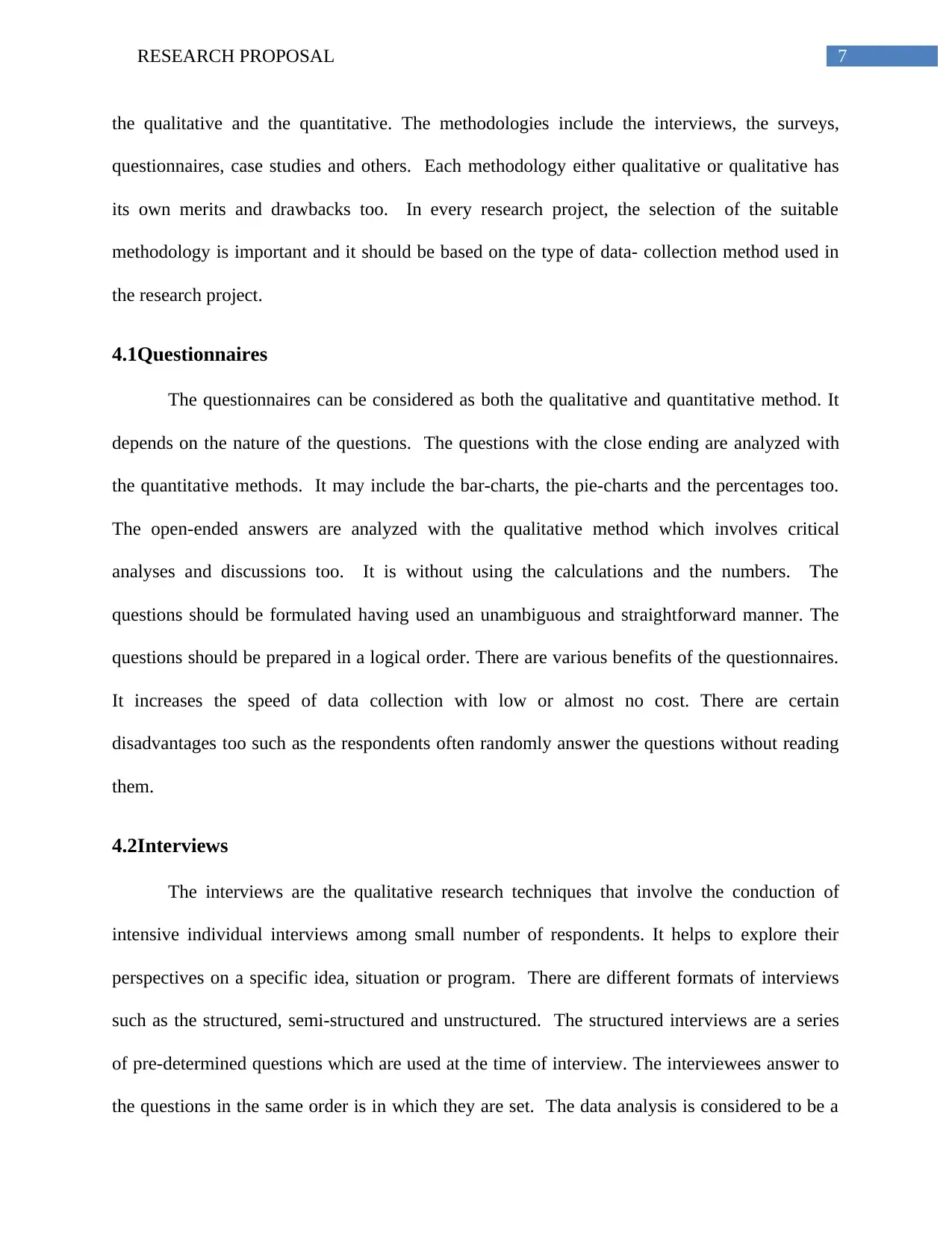
7RESEARCH PROPOSAL
the qualitative and the quantitative. The methodologies include the interviews, the surveys,
questionnaires, case studies and others. Each methodology either qualitative or qualitative has
its own merits and drawbacks too. In every research project, the selection of the suitable
methodology is important and it should be based on the type of data- collection method used in
the research project.
4.1Questionnaires
The questionnaires can be considered as both the qualitative and quantitative method. It
depends on the nature of the questions. The questions with the close ending are analyzed with
the quantitative methods. It may include the bar-charts, the pie-charts and the percentages too.
The open-ended answers are analyzed with the qualitative method which involves critical
analyses and discussions too. It is without using the calculations and the numbers. The
questions should be formulated having used an unambiguous and straightforward manner. The
questions should be prepared in a logical order. There are various benefits of the questionnaires.
It increases the speed of data collection with low or almost no cost. There are certain
disadvantages too such as the respondents often randomly answer the questions without reading
them.
4.2Interviews
The interviews are the qualitative research techniques that involve the conduction of
intensive individual interviews among small number of respondents. It helps to explore their
perspectives on a specific idea, situation or program. There are different formats of interviews
such as the structured, semi-structured and unstructured. The structured interviews are a series
of pre-determined questions which are used at the time of interview. The interviewees answer to
the questions in the same order is in which they are set. The data analysis is considered to be a
the qualitative and the quantitative. The methodologies include the interviews, the surveys,
questionnaires, case studies and others. Each methodology either qualitative or qualitative has
its own merits and drawbacks too. In every research project, the selection of the suitable
methodology is important and it should be based on the type of data- collection method used in
the research project.
4.1Questionnaires
The questionnaires can be considered as both the qualitative and quantitative method. It
depends on the nature of the questions. The questions with the close ending are analyzed with
the quantitative methods. It may include the bar-charts, the pie-charts and the percentages too.
The open-ended answers are analyzed with the qualitative method which involves critical
analyses and discussions too. It is without using the calculations and the numbers. The
questions should be formulated having used an unambiguous and straightforward manner. The
questions should be prepared in a logical order. There are various benefits of the questionnaires.
It increases the speed of data collection with low or almost no cost. There are certain
disadvantages too such as the respondents often randomly answer the questions without reading
them.
4.2Interviews
The interviews are the qualitative research techniques that involve the conduction of
intensive individual interviews among small number of respondents. It helps to explore their
perspectives on a specific idea, situation or program. There are different formats of interviews
such as the structured, semi-structured and unstructured. The structured interviews are a series
of pre-determined questions which are used at the time of interview. The interviewees answer to
the questions in the same order is in which they are set. The data analysis is considered to be a
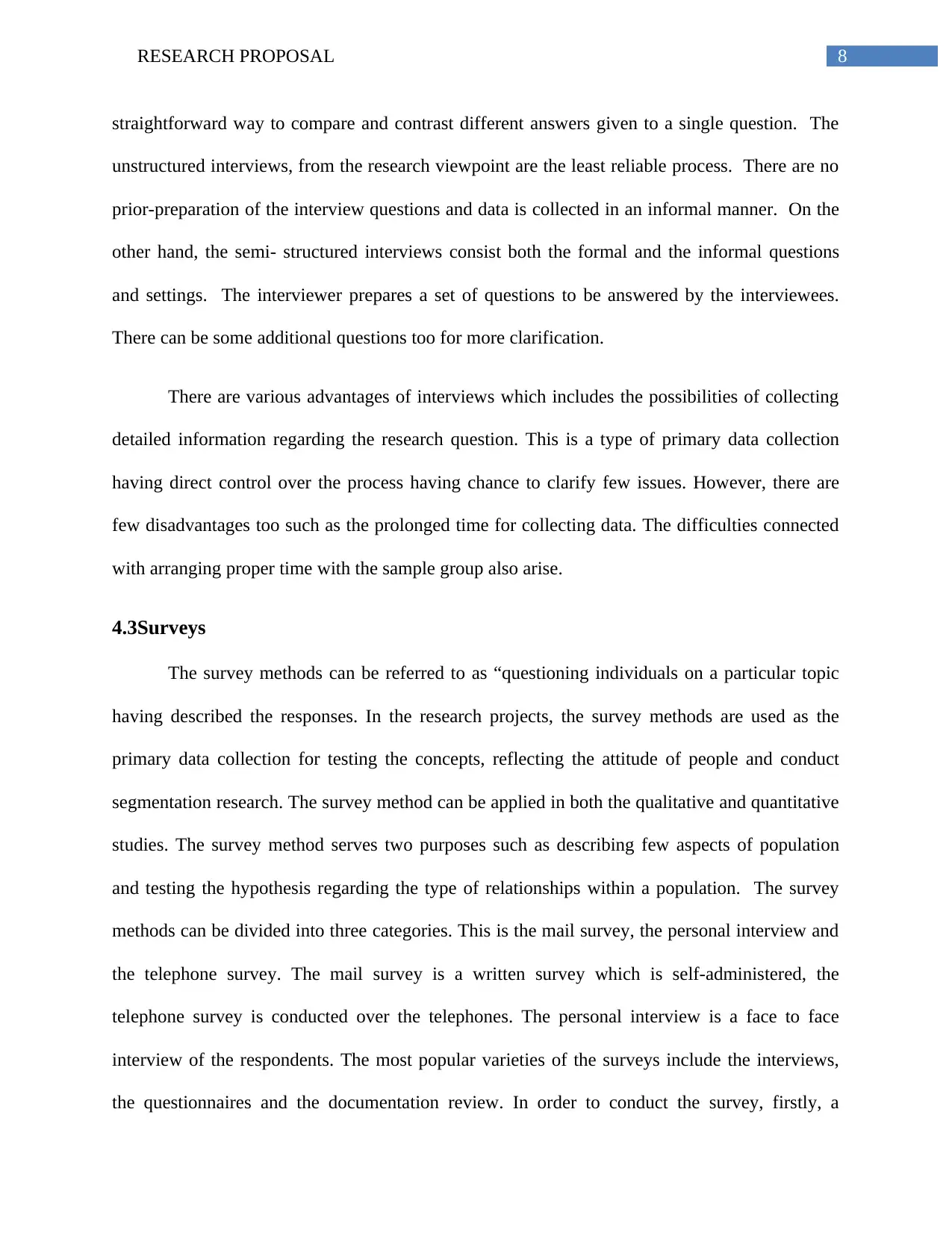
8RESEARCH PROPOSAL
straightforward way to compare and contrast different answers given to a single question. The
unstructured interviews, from the research viewpoint are the least reliable process. There are no
prior-preparation of the interview questions and data is collected in an informal manner. On the
other hand, the semi- structured interviews consist both the formal and the informal questions
and settings. The interviewer prepares a set of questions to be answered by the interviewees.
There can be some additional questions too for more clarification.
There are various advantages of interviews which includes the possibilities of collecting
detailed information regarding the research question. This is a type of primary data collection
having direct control over the process having chance to clarify few issues. However, there are
few disadvantages too such as the prolonged time for collecting data. The difficulties connected
with arranging proper time with the sample group also arise.
4.3Surveys
The survey methods can be referred to as “questioning individuals on a particular topic
having described the responses. In the research projects, the survey methods are used as the
primary data collection for testing the concepts, reflecting the attitude of people and conduct
segmentation research. The survey method can be applied in both the qualitative and quantitative
studies. The survey method serves two purposes such as describing few aspects of population
and testing the hypothesis regarding the type of relationships within a population. The survey
methods can be divided into three categories. This is the mail survey, the personal interview and
the telephone survey. The mail survey is a written survey which is self-administered, the
telephone survey is conducted over the telephones. The personal interview is a face to face
interview of the respondents. The most popular varieties of the surveys include the interviews,
the questionnaires and the documentation review. In order to conduct the survey, firstly, a
straightforward way to compare and contrast different answers given to a single question. The
unstructured interviews, from the research viewpoint are the least reliable process. There are no
prior-preparation of the interview questions and data is collected in an informal manner. On the
other hand, the semi- structured interviews consist both the formal and the informal questions
and settings. The interviewer prepares a set of questions to be answered by the interviewees.
There can be some additional questions too for more clarification.
There are various advantages of interviews which includes the possibilities of collecting
detailed information regarding the research question. This is a type of primary data collection
having direct control over the process having chance to clarify few issues. However, there are
few disadvantages too such as the prolonged time for collecting data. The difficulties connected
with arranging proper time with the sample group also arise.
4.3Surveys
The survey methods can be referred to as “questioning individuals on a particular topic
having described the responses. In the research projects, the survey methods are used as the
primary data collection for testing the concepts, reflecting the attitude of people and conduct
segmentation research. The survey method can be applied in both the qualitative and quantitative
studies. The survey method serves two purposes such as describing few aspects of population
and testing the hypothesis regarding the type of relationships within a population. The survey
methods can be divided into three categories. This is the mail survey, the personal interview and
the telephone survey. The mail survey is a written survey which is self-administered, the
telephone survey is conducted over the telephones. The personal interview is a face to face
interview of the respondents. The most popular varieties of the surveys include the interviews,
the questionnaires and the documentation review. In order to conduct the survey, firstly, a
⊘ This is a preview!⊘
Do you want full access?
Subscribe today to unlock all pages.

Trusted by 1+ million students worldwide
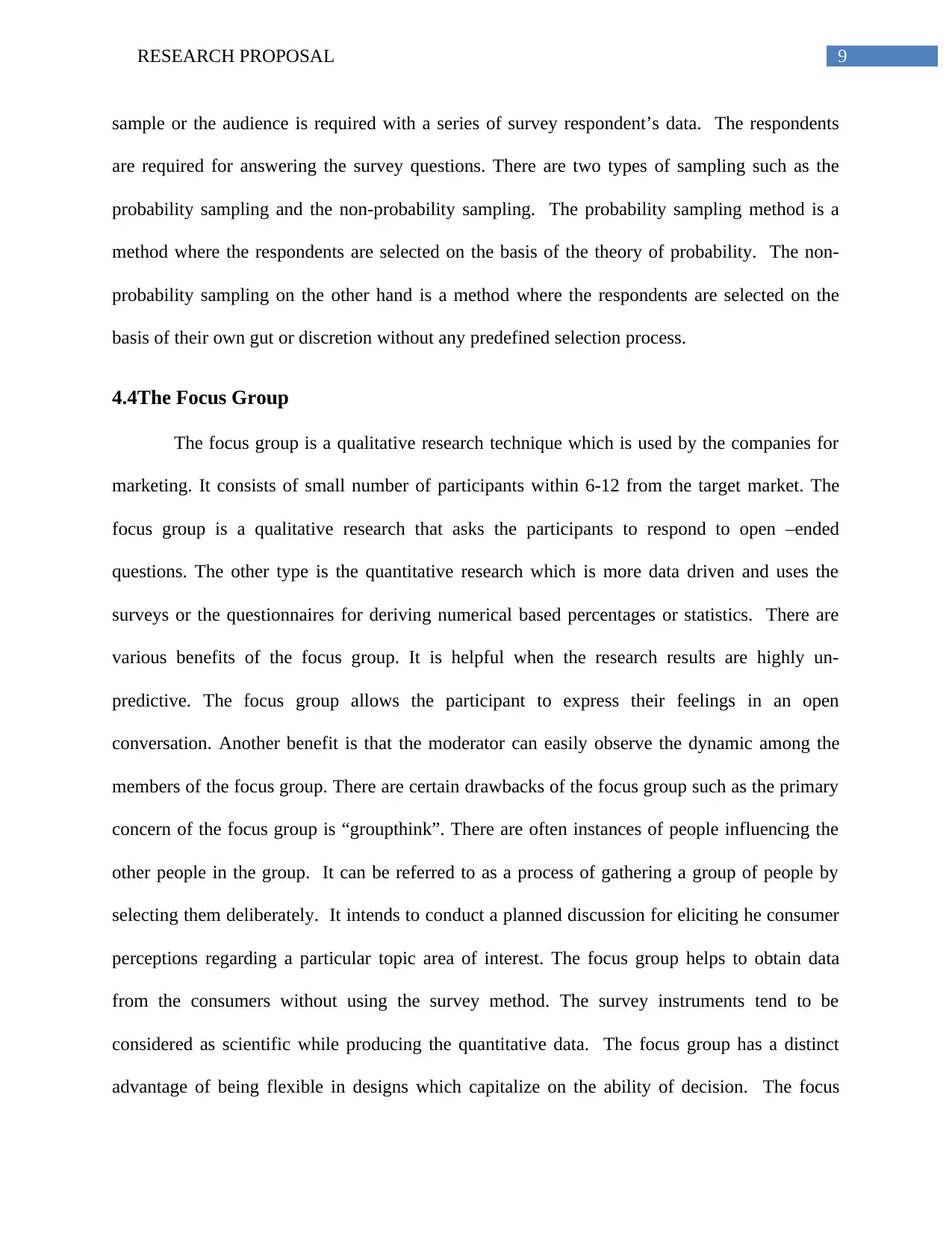
9RESEARCH PROPOSAL
sample or the audience is required with a series of survey respondent’s data. The respondents
are required for answering the survey questions. There are two types of sampling such as the
probability sampling and the non-probability sampling. The probability sampling method is a
method where the respondents are selected on the basis of the theory of probability. The non-
probability sampling on the other hand is a method where the respondents are selected on the
basis of their own gut or discretion without any predefined selection process.
4.4The Focus Group
The focus group is a qualitative research technique which is used by the companies for
marketing. It consists of small number of participants within 6-12 from the target market. The
focus group is a qualitative research that asks the participants to respond to open –ended
questions. The other type is the quantitative research which is more data driven and uses the
surveys or the questionnaires for deriving numerical based percentages or statistics. There are
various benefits of the focus group. It is helpful when the research results are highly un-
predictive. The focus group allows the participant to express their feelings in an open
conversation. Another benefit is that the moderator can easily observe the dynamic among the
members of the focus group. There are certain drawbacks of the focus group such as the primary
concern of the focus group is “groupthink”. There are often instances of people influencing the
other people in the group. It can be referred to as a process of gathering a group of people by
selecting them deliberately. It intends to conduct a planned discussion for eliciting he consumer
perceptions regarding a particular topic area of interest. The focus group helps to obtain data
from the consumers without using the survey method. The survey instruments tend to be
considered as scientific while producing the quantitative data. The focus group has a distinct
advantage of being flexible in designs which capitalize on the ability of decision. The focus
sample or the audience is required with a series of survey respondent’s data. The respondents
are required for answering the survey questions. There are two types of sampling such as the
probability sampling and the non-probability sampling. The probability sampling method is a
method where the respondents are selected on the basis of the theory of probability. The non-
probability sampling on the other hand is a method where the respondents are selected on the
basis of their own gut or discretion without any predefined selection process.
4.4The Focus Group
The focus group is a qualitative research technique which is used by the companies for
marketing. It consists of small number of participants within 6-12 from the target market. The
focus group is a qualitative research that asks the participants to respond to open –ended
questions. The other type is the quantitative research which is more data driven and uses the
surveys or the questionnaires for deriving numerical based percentages or statistics. There are
various benefits of the focus group. It is helpful when the research results are highly un-
predictive. The focus group allows the participant to express their feelings in an open
conversation. Another benefit is that the moderator can easily observe the dynamic among the
members of the focus group. There are certain drawbacks of the focus group such as the primary
concern of the focus group is “groupthink”. There are often instances of people influencing the
other people in the group. It can be referred to as a process of gathering a group of people by
selecting them deliberately. It intends to conduct a planned discussion for eliciting he consumer
perceptions regarding a particular topic area of interest. The focus group helps to obtain data
from the consumers without using the survey method. The survey instruments tend to be
considered as scientific while producing the quantitative data. The focus group has a distinct
advantage of being flexible in designs which capitalize on the ability of decision. The focus
Paraphrase This Document
Need a fresh take? Get an instant paraphrase of this document with our AI Paraphraser
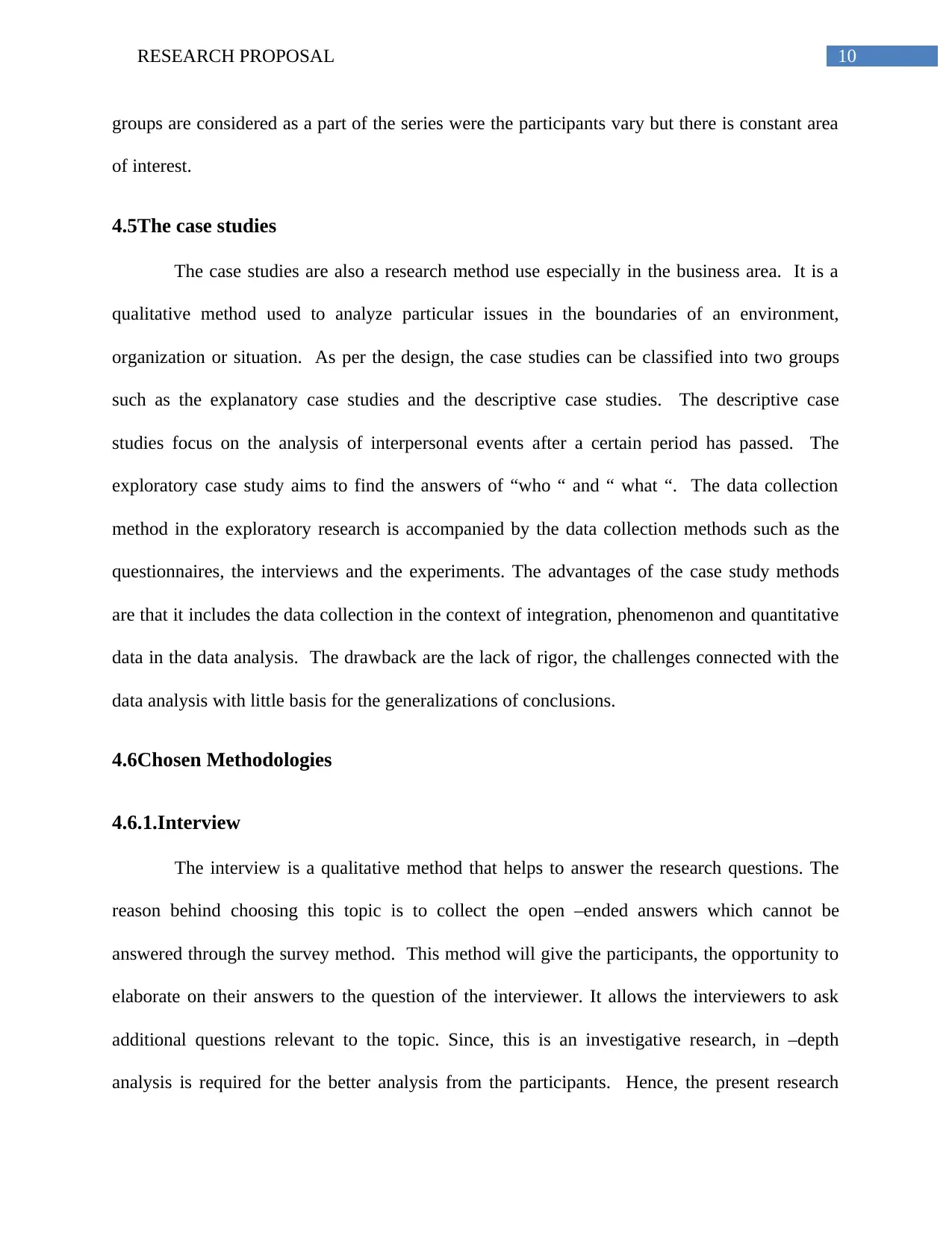
10RESEARCH PROPOSAL
groups are considered as a part of the series were the participants vary but there is constant area
of interest.
4.5The case studies
The case studies are also a research method use especially in the business area. It is a
qualitative method used to analyze particular issues in the boundaries of an environment,
organization or situation. As per the design, the case studies can be classified into two groups
such as the explanatory case studies and the descriptive case studies. The descriptive case
studies focus on the analysis of interpersonal events after a certain period has passed. The
exploratory case study aims to find the answers of “who “ and “ what “. The data collection
method in the exploratory research is accompanied by the data collection methods such as the
questionnaires, the interviews and the experiments. The advantages of the case study methods
are that it includes the data collection in the context of integration, phenomenon and quantitative
data in the data analysis. The drawback are the lack of rigor, the challenges connected with the
data analysis with little basis for the generalizations of conclusions.
4.6Chosen Methodologies
4.6.1.Interview
The interview is a qualitative method that helps to answer the research questions. The
reason behind choosing this topic is to collect the open –ended answers which cannot be
answered through the survey method. This method will give the participants, the opportunity to
elaborate on their answers to the question of the interviewer. It allows the interviewers to ask
additional questions relevant to the topic. Since, this is an investigative research, in –depth
analysis is required for the better analysis from the participants. Hence, the present research
groups are considered as a part of the series were the participants vary but there is constant area
of interest.
4.5The case studies
The case studies are also a research method use especially in the business area. It is a
qualitative method used to analyze particular issues in the boundaries of an environment,
organization or situation. As per the design, the case studies can be classified into two groups
such as the explanatory case studies and the descriptive case studies. The descriptive case
studies focus on the analysis of interpersonal events after a certain period has passed. The
exploratory case study aims to find the answers of “who “ and “ what “. The data collection
method in the exploratory research is accompanied by the data collection methods such as the
questionnaires, the interviews and the experiments. The advantages of the case study methods
are that it includes the data collection in the context of integration, phenomenon and quantitative
data in the data analysis. The drawback are the lack of rigor, the challenges connected with the
data analysis with little basis for the generalizations of conclusions.
4.6Chosen Methodologies
4.6.1.Interview
The interview is a qualitative method that helps to answer the research questions. The
reason behind choosing this topic is to collect the open –ended answers which cannot be
answered through the survey method. This method will give the participants, the opportunity to
elaborate on their answers to the question of the interviewer. It allows the interviewers to ask
additional questions relevant to the topic. Since, this is an investigative research, in –depth
analysis is required for the better analysis from the participants. Hence, the present research
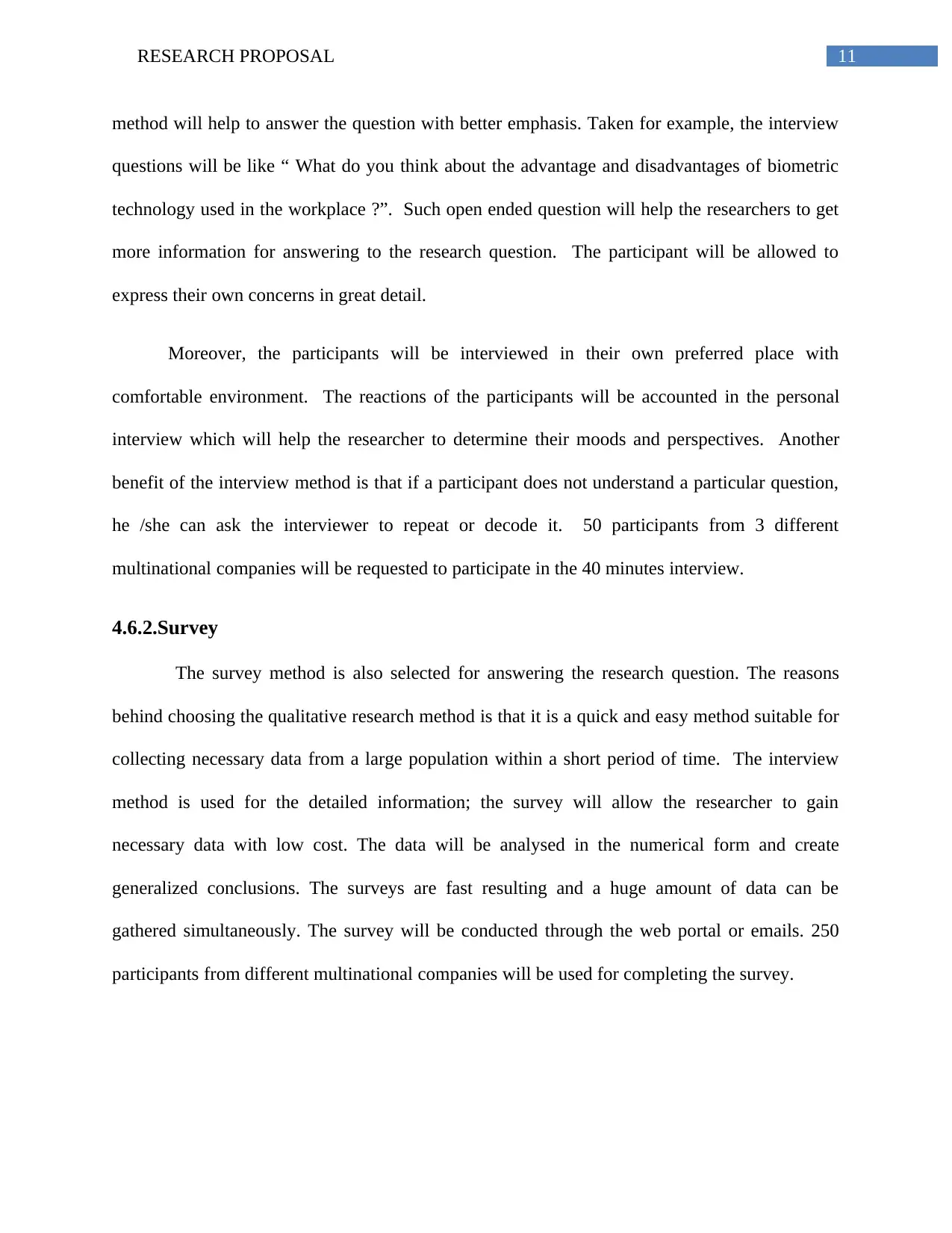
11RESEARCH PROPOSAL
method will help to answer the question with better emphasis. Taken for example, the interview
questions will be like “ What do you think about the advantage and disadvantages of biometric
technology used in the workplace ?”. Such open ended question will help the researchers to get
more information for answering to the research question. The participant will be allowed to
express their own concerns in great detail.
Moreover, the participants will be interviewed in their own preferred place with
comfortable environment. The reactions of the participants will be accounted in the personal
interview which will help the researcher to determine their moods and perspectives. Another
benefit of the interview method is that if a participant does not understand a particular question,
he /she can ask the interviewer to repeat or decode it. 50 participants from 3 different
multinational companies will be requested to participate in the 40 minutes interview.
4.6.2.Survey
The survey method is also selected for answering the research question. The reasons
behind choosing the qualitative research method is that it is a quick and easy method suitable for
collecting necessary data from a large population within a short period of time. The interview
method is used for the detailed information; the survey will allow the researcher to gain
necessary data with low cost. The data will be analysed in the numerical form and create
generalized conclusions. The surveys are fast resulting and a huge amount of data can be
gathered simultaneously. The survey will be conducted through the web portal or emails. 250
participants from different multinational companies will be used for completing the survey.
method will help to answer the question with better emphasis. Taken for example, the interview
questions will be like “ What do you think about the advantage and disadvantages of biometric
technology used in the workplace ?”. Such open ended question will help the researchers to get
more information for answering to the research question. The participant will be allowed to
express their own concerns in great detail.
Moreover, the participants will be interviewed in their own preferred place with
comfortable environment. The reactions of the participants will be accounted in the personal
interview which will help the researcher to determine their moods and perspectives. Another
benefit of the interview method is that if a participant does not understand a particular question,
he /she can ask the interviewer to repeat or decode it. 50 participants from 3 different
multinational companies will be requested to participate in the 40 minutes interview.
4.6.2.Survey
The survey method is also selected for answering the research question. The reasons
behind choosing the qualitative research method is that it is a quick and easy method suitable for
collecting necessary data from a large population within a short period of time. The interview
method is used for the detailed information; the survey will allow the researcher to gain
necessary data with low cost. The data will be analysed in the numerical form and create
generalized conclusions. The surveys are fast resulting and a huge amount of data can be
gathered simultaneously. The survey will be conducted through the web portal or emails. 250
participants from different multinational companies will be used for completing the survey.
⊘ This is a preview!⊘
Do you want full access?
Subscribe today to unlock all pages.

Trusted by 1+ million students worldwide
1 out of 32
Related Documents
Your All-in-One AI-Powered Toolkit for Academic Success.
+13062052269
info@desklib.com
Available 24*7 on WhatsApp / Email
![[object Object]](/_next/static/media/star-bottom.7253800d.svg)
Unlock your academic potential
Copyright © 2020–2025 A2Z Services. All Rights Reserved. Developed and managed by ZUCOL.





